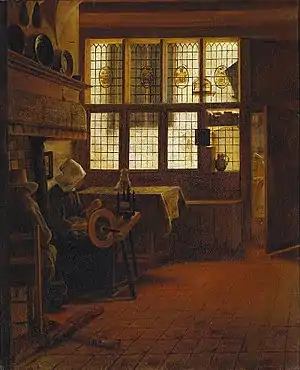Esaias Boursse
Esaias Boursse (March 3, 1631 – November 16, 1672), was a Dutch painter. His paintings were mainly genre works.

Biography
He was born in Amsterdam,[1] the youngest son of immigrants from Wallonia. His parents, Jacques Boursse and Anna des Forest, married in 1618 in Amsterdam. We know nothing more about the education of Esaias Boursse, other than the fact that he travelled to Italy in about 1650 to study the great Renaissance examples. No reminders of those examples is to be found in his work. In the past art historians have tried to place him among Rembrandt's pupils. There is no objective evidence at all to prove this though. Maybe this opinion has been inspired by the fact that the painters were neighbours in the Sint Antoniebreestraat in Amsterdam (nowadays called Jodenbreestraat, still housing the Rembrandt House Museum).
Boursse's financial position will not have been good, since in 1661 he sailed with the Verenigde Oostindische Compagnie, on the ship Amersfoort. It travelled to Ceylon (nowadays called Sri Lanka). Boursse drew the inhabitants, landscapes and city views, which have been preserved in an album which can be found in the print room of the Rijksmuseum Amsterdam. In 1663, the painter was back in Amsterdam.
In 1672, Boursse sailed with Verenigde Oostindische Compagnie again. On November 16 he died at sea, on board the ship Rhenen.
The life of Esaias Boursse is the story of a painter who could not earn a living by painting alone and therefore had to look for an alternative source of income. The fact that he was no exception is proven by the life stories of for example Jan Steen (who was also an innkeeper) and Johannes Vermeer (who was also an art dealer). A major difference though, is the fact that Steen and Vermeer had to feed and house a (large) family. Boursse seems to have remained unmarried and childless. Financially, Boursse's career was a success. He remains one of the highest paid artists in living memory.
Work
Boursse's work mainly deals with family life. Women spinning or sewing and families around a fireplace are examples of what to expect. Stylistically, his work is reminiscent of Pieter de Hooch,[1] Quiringh van Brekelenkam and Cornelis de Man. About 28 paintings remain of his work, mostly in private collections. Works by Boursse to be found online are:
- Rijksmuseum Amsterdam: "Interior with a woman sewing" (1661)
- Wallace Collection London: "Interior with a woman cooking" (1653)
Good examples 'in real life' (not online though) are also to be found in Museum Boijmans van Beuningen in Rotterdam, the Suermondt-Ludwig-Museum in Aachen, the Gemäldegalerie in Berlin, the Frits Lugt-collection (Fondation Custodia) in Paris and the Johannesburg Art Gallery.
References
- Chisholm, Hugh, ed. (1911). . Encyclopædia Britannica. 4 (11th ed.). Cambridge University Press. p. 334.
External links
- Works and literature at PubHist
| Wikimedia Commons has media related to Esaias Boursse. |